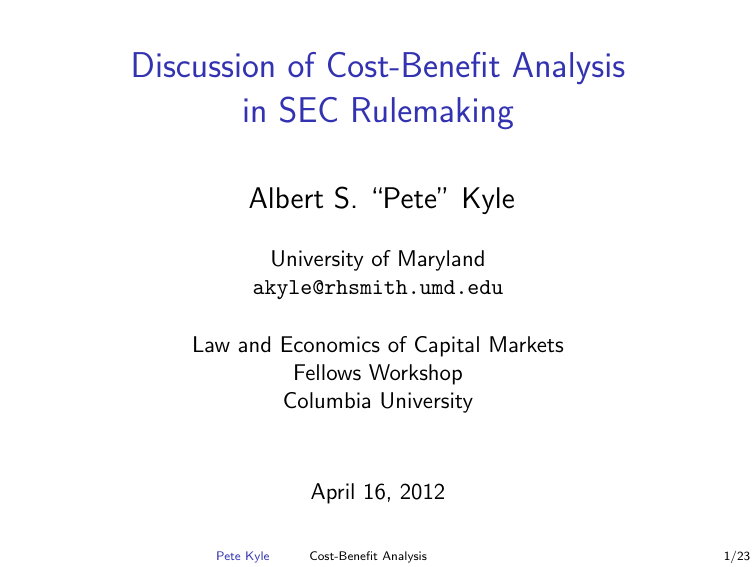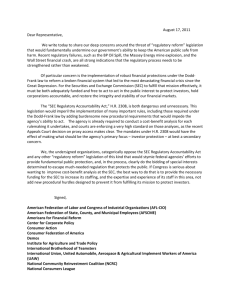Discussion of Cost-Benefit Analysis in SEC Rulemaking Albert S. “Pete” Kyle
advertisement

Discussion of Cost-Benefit Analysis in SEC Rulemaking Albert S. “Pete” Kyle University of Maryland akyle@rhsmith.umd.edu Law and Economics of Capital Markets Fellows Workshop Columbia University April 16, 2012 Pete Kyle Cost-Benefit Analysis 1/23 Disclaimer These slides are meant to provide preliminary thoughts for the purpose of stimulating discussion. These slides do not necessarily represent the views of the Securities and Exchange Commission, its Commissioners, or its staff. Pete Kyle Cost-Benefit Analysis 2/23 Goal: Use SEC’s OIG Audit as Background for Discussion of Cost-Benefit Analysis in SEC Rulemaking. Follow-Up Review of Cost-Benefit Analyses in Selected SEC Dodd-Frank Act Rulemakings (January 27, 2012, Report No. 499) examined: I Say-on-pay. I Asset-backed securities (ABS) disclosure. I ABS due diligence. I Security-based swap reporting (SBSR) (interim final temporary rule and proposed rue). Previous report examined credit risk retention, clearing agency governance standards, registration of swap execution facilities, reporting by investment advisors to private funds, municipal advisor registration, conflict minerals. I worked as a consultant to the OIG, under the supervision of David Kotz. Pete Kyle Cost-Benefit Analysis 3/23 Recommendations of OIG Study 1. Involve economists more actively in both qualitative and quantitative analysis. 2. Consider using a pre-statute baseline instead of restricting analysis to SEC exercise of discretion. 3. Use baselines consistently. 4. Integrate discussion of cost-benefit analysis into rule release. 5. Discuss market failure explicitly; in the absence of market failure, spell out other compelling social purpose. 6. Include internal SEC costs. Pete Kyle Cost-Benefit Analysis 4/23 Involve economists more actively in both qualitative and quantitative analysis. I The SEC follows a systematic process for cost-benefit analysis, adhering to own internal guidelines. I CBA quantifies PRA costs and uses quantitative data to describe affected markets, but does not quantify benefits or non-PRA costs. I RiskFin Economists are involved in preparing and commenting on cost-benefit analyses. Pete Kyle Cost-Benefit Analysis 5/23 My Opinions I Economists play crucial role in both qualitative and quantitative analysis, especially where quantitative analysis is needed. I Quantitative analysis greatly facilitated when economists already have expertise in specialized data. I Even more thorough cost-benefit analysis would result from making the already significant involvement of economists even more extensive. I SEC economists have high level of expertise, but heavy DFA rulemaking agenda is stretching this expertise thin. I Proxy access case incorporates expectation of a high level of economic analysis. *Conclusion: SEC needs to increase the ratio of economists to lawyers from 30-to-3000+ towards a much higher ratio. Pete Kyle Cost-Benefit Analysis 6/23 Consider using a pre-statute baseline instead of restricting analysis to SEC exercise of discretion. I OIG recommendation is opposite from the “Becker memo,” which makes a case for restricting cost-benefit analysis to explaining SEC’s use of discretion. I Becker memo consistent with using a post-statute baseline. Pete Kyle Cost-Benefit Analysis 7/23 “Becker Memo” Excerpt “Where the Commission has a degree of discretion, the release should identify the discretion the Commission is exercising, the choices being made, and the rationale for those choices. To the extent that the Commission is exercising discretion, the release should discuss the costs and benefits of the choices proposed or adopted, including where possible, a quantification of the costs and benefits. With respect to those choices made by Congress, the release generally should cite to the legislative record to support and explain the benefits Congress intended by enacting the provision, but only as a matter of citation and not as a matter of assertion by the Commission.” “Where the Commission has no discretion, the release should say so. Because the Commission is making no policy choices, there are no choices to analyze or explain.” Pete Kyle Cost-Benefit Analysis 8/23 *Potential Justifications for Becker Memo: I *Cost-benefit analysis needs to be done on tight time frame. I *SEC lacks resources to do more extensive analysis required by pre-statute benchmark. I *Legal mandate is to explain discretion only, not more. I *SEC may not want to second-guess Congress. I *SEC may have internal disagreements concerning content of more extensive analysis. Pete Kyle Cost-Benefit Analysis 9/23 My Opinions I Cost-benefit analysis informs the public, informs other parts of the government (including Congress), and helps the SEC itself make informed decisions. I Restricting attention to exercise of discretion reduces ability of cost-benefit analysis to serve these broader goals. I *Retrospective reviews of regulations and Congressional follow-up actions would benefit from cost-benefit analysis based on a pre-statute baseline. I It is hard to separate analysis of incremental costs and benefits of discretion from overall analysis. Example: Benefits are 1% of market cap, costs are $1 million per firm, SEC considers discretionary exemption of small firms. Pete Kyle Cost-Benefit Analysis 10/23 Examples I Say-on-Pay: SEC exempted small issuers. I ABS Due Diligence: SEC requires disclosures to be accurate and requires specific findings be disclosed. How can this be justified without understanding the benefits of say-on-pay relative to a pre-statute baseline? Pete Kyle Cost-Benefit Analysis 11/23 Use baselines consistently Example: Municipal advisor registration. Municipal advisor registration provides an example of an ambiguous use of baselines. Baseline might be: 1. Market shuts down if SEC does not provide a rule to keep it open. 2. Congress mandates a minimal registration process with respect to which the SEC has discretion to make minor modifications. 3. Advisors continue pre-statute activities with minimal disruption (pre-statute benchmark). The registration rules use these different benchmarks in a confusing and inconsistent manner. Pete Kyle Cost-Benefit Analysis 12/23 Use baselines consistently Example: SBSR Establishing baselines is complicated because: I Rule interacts with many other rules defining security-based swaps, swap data repositories, “real time,” and these rules require coordination with other agencies (e.g. CFTC). I SBSR is a collection of 13 different rules which interact with one another in complicated ways. SEC attempts to measure costs and benefits of each rule separately, but baselines are not well-defined. Example: Does baseline for reporting requirements (rule 901 and 902) presume a rule requiring error correction is in place (rule 905)? I The cost-benefit analysis states that because the SEC does not have discretion to extend the reach of U.S. law to foreign jurisdictions, there are no costs or benefits other than those inherent in the Dodd-Frank Act. The costs and benefits associated with the swaps business moving offshore do not disappear because the DFA does not address the issue. Pete Kyle Cost-Benefit Analysis 13/23 Integrate discussion of cost-benefit analysis into rule release. I Typical rule structure: legal basis for the rule, the market the rule regulates, the content of the proposed or final rule, and reasons for choices made in determining the rules content, followed by separate sections containing PRA cost estimates, the cost-benefit analysis, and a discussion of the rules effect on efficiency, competition, and capital formation (ECCF). I Credit risk retention: SEC added separate discussion to rule. I SEC has been considering combining CBA and ECCF sections into one section. I Municipal Advisor Registration: Combined CBA and ECCF into one section. Pete Kyle Cost-Benefit Analysis 14/23 My Opinions I Combined CBA and ECCF analysis eliminates redundancy. I *Analysis of the market, both qualitative and quantitative, is part of the cost-benefit analysis. I *Proxy access case makes it clear that courts see cost-benefit analysis (same as “economic analysis”) throughout the rule, not just in designated sections. Pete Kyle Cost-Benefit Analysis 15/23 Discuss market failure explicitly; in the absence of market failure, spell out other compelling social purpose. I OMB Circular A-4: “If the regulation is designed to correct a significant market failure, you should describe the failure both qualitatively and (where feasible) quantitatively.” I Three major types of market failures are externalities, market power, inadequate or asymmetric information. I Some rules allude to market failures but do not spell out a theory. I Other rules erroneously suggest a market failure but do not spell out an alternative justification for regulation. Pete Kyle Cost-Benefit Analysis 16/23 My Opinions: SBSR I I SEC rule alludes to market failure but does not spell it out. A good cost-benefit analysis would be complicated because there are many market failures which interact with one another: I I I Asymmetric information: fundamental information, information about others bids and offers, information about past trades and future trading intentions. Speed of processing information varies across participants. Monopoly power: Large dealers can move prices; economies of scale in collecting and reporting market data. Externalities: Adverse selection from better informed trading undermines liquidity provided to uninformed traders. Information reflected in prices is helpful for economic decisions which do not involve trading. Shared data standards are like a public good. Pete Kyle Cost-Benefit Analysis 17/23 My Opinions: ABS Due Diligence I The following is not a market failure theory: “As a result of the financial crisis and subsequent events, the market for securitization has declined due, in part, to perceived uncertainty about the accuracy of information about the pools backing the [asset-backed securities] and perceived problems in the securitization process that affected investors willingness to participate in these offerings. Greater transparency of the review performed on the underlying assets would decrease the uncertainty about pool information and, thus, should help investors price these products more accurately.” I No discussion of alternative compelling social purpose. I *SEC could have justified rule based on investor protection: ABS market did not perform well because markets made mistakes, not because of market failure. Pete Kyle Cost-Benefit Analysis 18/23 My Opinions: Credit Risk Retention I Analysis focusses on misaligned incentives, which are a fact of life and not a market failure theory. I Rule does not discuss a compelling social purpose either. I *SEC could have justified rule on the basis of investor protection. Competitive unregulated market forces create profit motives for markets to fix problems of misaligned incentives, but sometimes markets make mistakes which are privately and socially costly. Therefore a good idea to wear a government designed belt, in case the market-supplied suspenders fail to work effectively. Pete Kyle Cost-Benefit Analysis 19/23 Include internal SEC costs. I Some DFA rules have significant implications for SEC internal costs. I Rules do not examine SEC costs, but they are part of the SEC budget. I CFTC OIG made similar recommendation. Pete Kyle Cost-Benefit Analysis 20/23 My Opinions I Congress, the public, and the SEC itself should be interested in whether the SEC has the resources to achieve the benefits that rules imply. I Example: Muni advisor registration: SEC incurs significant costs in running a system of enhanced oversight. Will enforcement costs go up or down as a result of enhanced system of oversight? Does SEC need to hire more or fewer people in enforcement? I Example: SBSR: SEC will collect an enormous amount of data and will need significant resources to extract benefits from increased oversight. How many economists, statisticians, and other employees are needed to achieve the benefits of enhanced reporting to the SEC? Pete Kyle Cost-Benefit Analysis 21/23 *Thoughts related to Proxy Access Case: Challenge to Provide Objective Economic Analysis. I *Proxy access case incorporates expectation of a high level of economic analysis. I *Proxy access case incorporates expectation that economic analysis is balanced, looking at both sides of issue in an objective manner. I *If 100 arguments are examined and all 100 favor a regulation, then analysis is probably biased. Objective balance favoring a beneficial regulation might be 60-40. I *Therefore it is important for SEC economists not to become politicized in the future. Pete Kyle Cost-Benefit Analysis 22/23 Additional thoughts related to Proxy Access Case I *In cases where there is no market failure, can investor protection be a justification for regulation? I *Cost-benefit analysis reflects ability of retrospective analysis to improve or modify rules. I *Good idea to incorporate controlled experiments into regulation, so that cost-benefit analysis can be more accurate. Pete Kyle Cost-Benefit Analysis 23/23



